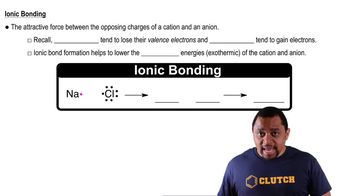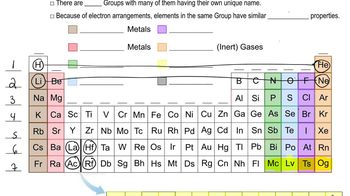Here are the essential concepts you must grasp in order to answer the question correctly.
Ionic Bonding
Ionic bonding occurs when one atom donates an electron to another, resulting in the formation of charged ions. Metals typically lose electrons to form positive ions (cations), while nonmetals gain electrons to form negative ions (anions). In this question, the presence of X2+ and Y- ions suggests that X is likely a metal that has lost electrons, while Y is a nonmetal that has gained electrons.
Recommended video:
Periodic Table Groups
Elements in the periodic table are organized into groups based on their similar properties and electron configurations. Metals are generally found on the left side and in the center of the table, particularly in groups 1 (alkali metals) and 2 (alkaline earth metals), while nonmetals are located on the right side, primarily in groups 15 to 17 (the p-block). Understanding these groupings helps predict the behavior of elements during reactions.
Recommended video:
Periodic Table: Group Names
Metal vs. Nonmetal Properties
Metals are typically characterized by their ability to conduct electricity, malleability, ductility, and tendency to lose electrons during chemical reactions. In contrast, nonmetals are usually poor conductors, brittle in solid form, and tend to gain electrons. Recognizing these properties is essential for determining whether elements X and Y are metals or nonmetals based on their ionic forms.
Recommended video:
 McMurry 8th Edition
McMurry 8th Edition Ch.6 - Ionic Compounds: Periodic Trends and Bonding Theory
Ch.6 - Ionic Compounds: Periodic Trends and Bonding Theory Problem 79
Problem 79 Verified step by step guidance
Verified step by step guidance

